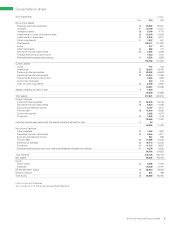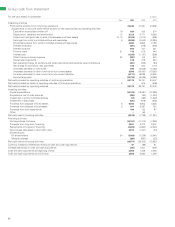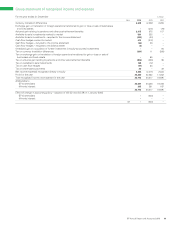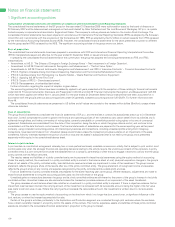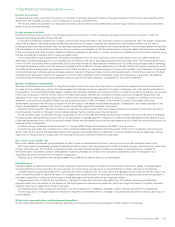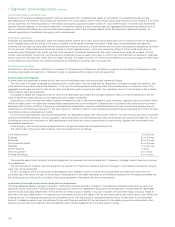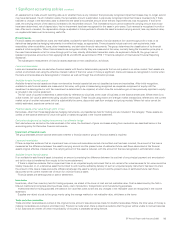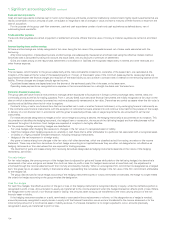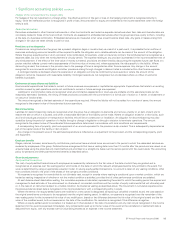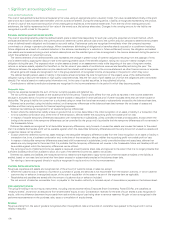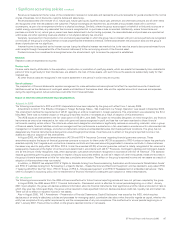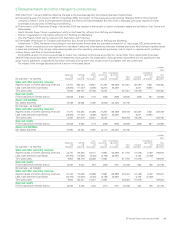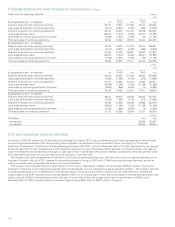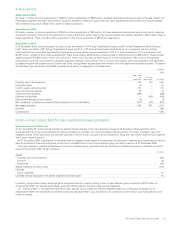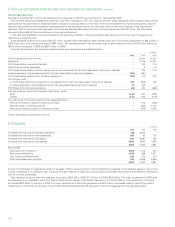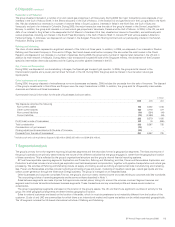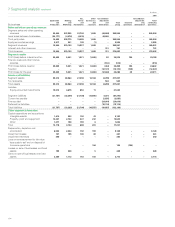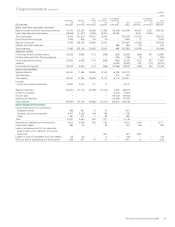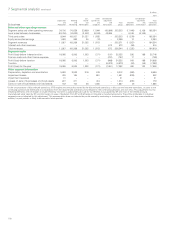BP 2006 Annual Report Download - page 108
Download and view the complete annual report
Please find page 108 of the 2006 BP annual report below. You can navigate through the pages in the report by either clicking on the pages listed below, or by using the keyword search tool below to find specific information within the annual report.106
1 Significant accounting policies continued
Cash-settled transactions
The cost of cash-settled transactions is measured at fair value using an appropriate option valuation model. Fair value is established initially at the grant
date and at each balance sheet date thereafter until the awards are settled. During the vesting period, a liability is recognized representing the product
of the fair value of the award and the portion of the vesting period expired as at the balance sheet date. From the end of the vesting period until
settlement, the liability represents the full fair value of the award as at the balance sheet date. Changes in the carrying amount for the liability are
recognized in profit or loss for the period.
Pensions and other post-retirement benefits
The cost of providing benefits under the defined benefit plans is determined separately for each plan using the projected unit credit method, which
attributes entitlement to benefits to the current period (to determine current service cost) and to the current and prior periods (to determine the present
value of defined benefit obligation) and is based on actuarial advice. Past service costs are recognized immediately when the company becomes
committed to a change in pension plan design. When a settlement (eliminating all obligations for benefits already accrued) or a curtailment (reducing
future obligations as a result of a material reduction in the scheme membership or a reduction in future entitlement) occurs, the obligation and related
plan assets are remeasured using current actuarial assumptions and the resultant gain or loss is recognized in the income statement during the period in
which the settlement or curtailment occurs.
The interest element of the defined benefit cost represents the change in present value of scheme obligations resulting from the passage of time,
and is determined by applying the discount rate to the opening present value of the benefit obligation, taking into account material changes in the
obligation during the year. The expected return on plan assets is based on an assessment made at the beginning of the year of long-term market
returns on scheme assets, adjusted for the effect on the fair value of plan assets of contributions received and benefits paid during the year. The
difference between the expected return on plan assets and the interest cost is recognized in the income statement as other finance income or expense.
Actuarial gains and losses are recognized in full in the group statement of recognized income and expense in the period in which they occur.
The defined benefit pension asset or liability in the balance sheet comprises the total for each plan of the present value of the defined benefit
obligation (using a discount rate based on high quality corporate bonds), less the fair value of plan assets out of which the obligations are to be settled
directly. Fair value is based on market price information and, in the case of quoted securities, is the published bid price.
Contributions to defined contribution schemes are recognized in the income statement in the period in which they become payable.
Corporate taxes
Income tax expense represents the sum of the tax currently payable and deferred tax.
The tax currently payable is based on the taxable profits for the period. Taxable profit differs from net profit as reported in the income statement
because it excludes items of income or expense that are taxable or deductible in other periods and it further excludes items that are never taxable or
deductible. The group’s liability for current tax is calculated using tax rates that have been enacted or substantively enacted by the balance sheet date.
Deferred tax is provided, using the liability method, on all temporary differences at the balance sheet date between the tax bases of assets and
liabilities and their carrying amounts for financial reporting purposes.
Deferred tax liabilities are recognized for all taxable temporary differences:
– Except where the deferred tax liability arises on goodwill that is not tax deductible or the initial recognition of an asset or liability in a transaction that
is not a business combination and, at the time of the transaction, affects neither the accounting profit nor taxable profit or loss.
– In respect of taxable temporary differences associated with investments in subsidiaries, jointly controlled entities and associates, except where the
timing of the reversal of the temporary differences can be controlled by the group and it is probable that the temporary differences will not reverse in
the foreseeable future.
Deferred tax assets are recognized for all deductible temporary differences, carry-forward of unused tax assets and unused tax losses, to the extent
that it is probable that taxable profit will be available against which the deductible temporary differences and the carry-forward of unused tax assetsand
unused tax losses can be utilized:
– Except where the deferred income tax asset relating to the deductible temporary difference arises from the initial recognition of an asset or liability in
transaction that is not a business combination and, at the time of the transaction, affects neither the accounting profit nor taxable profit or loss.
– In respect of deductible temporary differences associated with investments in subsidiaries, jointly controlled entities and associates, deferred tax
assets are only recognized to the extent that it is probable that the temporary differences will reverse in the foreseeable future and taxable profit will
be available against which the temporary differences can be utilized.
The carrying amount of deferred income tax assets is reviewed at each balance sheet date and reduced to the extent that it is no longer probable that
sufficient taxable profit will be available to allow all or part of the deferred income tax asset to be utilized.
Deferred tax assets and liabilities are measured at the tax rates that are expected to apply to the year when the asset is realized or the liability is
settled, based on tax rates (and tax laws) that have been enacted or substantively enacted at the balance sheet date.
Tax relating to items recognized directly in equity is recognized in equity and not in the income statement.
Customs duties and sales taxes
Revenues, expenses and assets are recognized net of the amount of customs duties or sales tax except:
– Where the customs duty or sales tax incurred on a purchase of goods and services is not recoverable from the taxation authority, in which case the
customs duty or sales tax is recognized as part of the cost of acquisition of the asset or as part of the expense item as applicable.
– Receivables and payables are stated with the amount of customs duty or sales tax included.
The net amount of sales tax recoverable from, or payable to, the taxation authority is included as part of receivables or payables in the balance sheet.
Own equity instruments
The group’s holding in its own equity instruments, including ordinary shares held by Employee Share Ownership Plans (ESOPs), are classified as
‘treasury shares’, and shown as deductions from shareholders’ equity at cost. Consideration received for the sale of such shares is also recognized in
equity, with any difference between the proceeds from sale and the original cost being taken to revenue reserves. No gain or loss is recognized in the
performance statements on the purchase, sale, issue or cancellation of equity shares.
Revenue
Revenue arising from the sale of goods is recognized when the significant risks and rewards of ownership have passed to the buyer and it can be
reliably measured.



